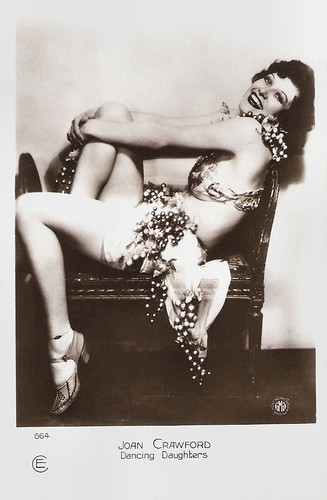
French postcard by Cinémagazine-Edition, no. 664. Photo: MGM. Joan Crawford in Our Dancing Daughters (Harry Beaumont, 1928).

Joan Crawford and her first husband, Douglas Fairbanks Jr. German postcard by Ross Verlag, Berlin, no. 4628/1, 1929-1930. Photo: Metro-Goldwyn-Mayer.
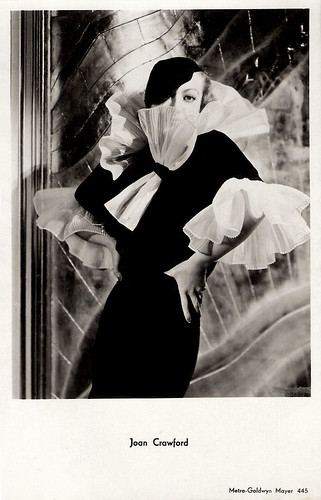
Dutch postcard by H.A.T.E., Rotterdam, no. 445, sent by mail in the Netherlands in 1934. Photo: George Hurrell / MGM (Metro-Goldwyn-Mayer).
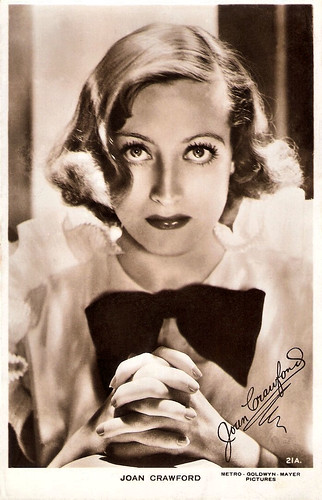
British Real Photograph postcard by Milton, no. 21A. Photo: Metro-Goldwyn-Mayer.
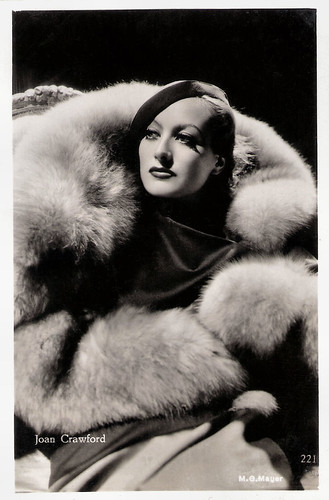
Dutch postcard by JosPe, no. 221. Photo: George Hurrell / Metro-Goldwyn-Mayer.
The free-spirited, all-American girl
Joan Crawford was born Lucille Fay LeSueur in 1904, in San Antonio, Texas. Her parents were Anna Belle (Johnson) and Thomas E. LeSueur, a laundry labourer. By the time she was born, her parents had separated. The young Lucille was bullied and shunned at Scaritt Elementary School in Kansas City by the other students due to her poor home life. She worked with her mother in a laundry and felt that her classmates could smell the chemicals and cleaners on her. She said that her love of taking showers and being obsessed with cleanliness had begun early in life as an attempt to wash off the smell of the laundry. Her stepfather Henry Cassin allegedly began sexually abusing her when she was eleven years old, and the abuse continued until she was sent to St. Agnes Academy, a Catholic girls' school. By the time she was a teenager, she'd had three stepfathers.
Lucille LeSueur worked a variety of menial jobs. She was a good dancer, though, and she entered several contests, one of which landed her a spot in a chorus line. Before long, she was dancing in the choruses of travelling revues in big Midwestern and East Coast cities. She was spotted dancing in Detroit by famous New York producer Jacob J. Shubert. Shubert put her in the chorus line for his show 'Innocent Eyes'(1924) at the Winter Garden Theatre on Broadway. Then followed another Schubert production, 'The Passing Show of 1924'. After-hours, she danced for pay in the town it-spot, Club Richman, which was run by the 'Passing Show' stage manager Nils Granlund and popular local personality Harry Richman. In December 1924, Granlund called Lucille to tell her that Al Altman, a NYC-based talent scout from MGM had caught her in 'The Passing Show of 1924' and wanted her to do a screen test. Metro-Goldwyn-Mayer (MGM) offered Crawford a contract at $75 a week. On New Year's Day 1925, she boarded the train for Culver City.
Credited as Lucille LeSueur, her first film part was as a showgirl in Lady of the Night (Monta Bell, 1925), starring MGM's most popular female star, Norma Shearer. Crawford was determined to succeed, and shortly after she also appeared in The Circle (Frank Borzage, 1925) and Pretty Ladies (Monta Bell, 1925), starring comedian ZaSu Pitts. She also appeared in a small role in Erich von Stroheim's classic The Merry Widow (1925) with Mae Murray and John Gilbert. MGM publicity head Pete Smith recognised her ability to become a major star but felt her name sounded fake. He told studio head, Louis B. Mayer, that her last name, LeSueur, reminded him of a sewer. Smith organised a contest called 'Name the Star' in Movie Weekly to allow readers to select her new stage name. The initial choice was 'Joan Arden', but after another actress was found to have prior claim to that name, the alternate surname 'Crawford' became the choice.
She first made an impression on audiences in Edmund Goulding's showgirl tale Sally, Irene and Mary (1925). The film, which co-starred Constance Bennett and Sally O'Neil, was a hit. Joan's popularity grew so quickly afterwards that two films in which she was still billed as Lucille Le Sueur: Old Clothes (Edward F. Cline, 1925) with Jackie Coogan, and The Only Thing (Jack Conway, 1925) were recalled, and her name on the billings was changed to Joan Crawford. In 1926, Crawford was named one of the WAMPAS Baby Stars, and she starred opposite Charles Ray in Paris (Edmund Goulding, 1926). Within a few years, she became the romantic female lead to many of MGM's top male stars, including Ramón Novarro, John Gilbert, and action star Tim McCoy. She appeared alongside her close friend, William Haines in the comedy Spring Fever (Edward Sedgwick, 1927). It was the second film starring Haines and Crawford (the first had been Sally, Irene and Mary (1925)), and their first onscreen romantic teaming. Then, Crawford appeared in the silent horror film The Unknown (Tod Browning, 1927), starring Lon Chaney, Sr., who played Alonzo the Armless, a circus freak who uses his feet to toss knives. Crawford played his skimpily-clad young carnival assistant whom he hopes to marry. She stated that she learned more about acting from watching Chaney work than from anyone else in her career.
Her role as Diana Medford in Our Dancing Daughters (Harry Beaumont, 1928) elevated her to star status. Joan co-starred with Anita Page and Dorothy Sebastian, and her spunky wild-but-moral flapper character struck a chord with the public and zeitgeist. Wikipedia: "The role established her as a symbol of modern 1920s-style femininity which rivalled Clara Bow, the original It girl, then Hollywood's foremost flapper. A stream of hits followed Our Dancing Daughters, including two more flapper-themed movies, in which Crawford embodied for her legion of fans (many of whom were women) an idealized vision of the free-spirited, all-American girl." The fan mail began pouring in and from that point on Joan was a bonafide star. Crawford had cleared the first big hurdle; now came the second, in the form of talkies. But Crawford wasn't felled by sound. Her first talkie, the romantic drama Untamed (Jack Conway, 1929) with Robert Montgomery, was a success. Michael Eliott at IMDb: "It's rather amazing to see how well she transformed into a sound star and you have to think that she was among the best to do so."

German postcard by Ross Verlag, no. 3775/1, 1928-1929. Photo: Metro-Goldwyn-Mayer. Joan Crawford and Ramón Novarro in Across to Singapore (William Nigh, 1928).

German postcard by Ross Verlag, no. 4260/1, 1929-1930. Photo: Metro-Goldwyn-Mayer. Nils Asther and Joan Crawford in Dream of Love (Fred Niblo, 1928).
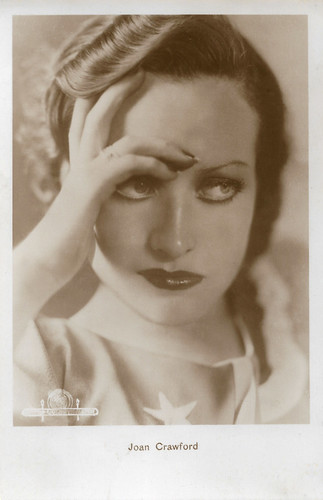
Belgian postcard by P.I.A. Belga Phot., Bruxelles. Photo: Metro-Goldwyn-Mayer. Caption: Les plus beaux films sont interprétés par les stars de la Metro GOLDWYN Mayer.
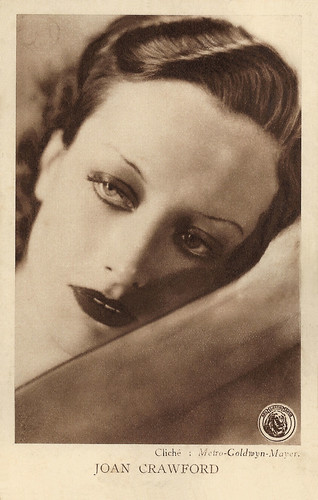
Belgian postcard by S.A. Cacao et Chocolat Kivou, Vilvoorde / N.V. Cacao en Chocolade Kivou, Vilvoorde. Photo: Metro-Goldwyn-Mayer (MGM).
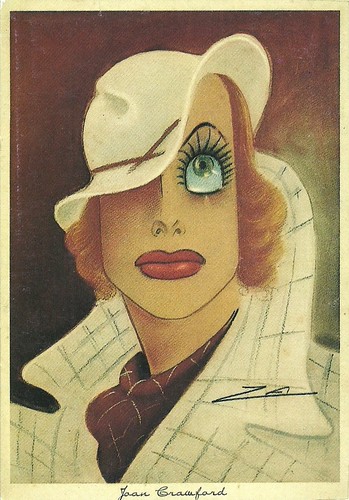
Italian postcard. Caricature by [Zeb].
The Woman with the Smear
In the early 1930s, tired of playing fun-loving flappers, Joan Crawford wanted to change her image. Thin lips would not do for her; she wanted big lips. Ignoring her natural lip contours, Max Factor ran a smear of colour across her upper and lower lips. It was just what she wanted. To Max, the Crawford look, which became her trademark, was always 'the smear'. As the 1930s progressed, Joan Crawford became one of the biggest stars at MGM. She developed a glamorous screen image, appearing often as a sumptuously gowned, fur-draped, successful career woman. She was in top form in films such as Grand Hotel (Edmund Goulding, 1932), Sadie McKee (Clarence Brown, 1934), No More Ladies (Edward H. Griffith, 1935), and Love on the Run (W.S. Van Dyke, 1936) with Clark Gable.
Crawford often played hard-working young women who found romance and success. Movie patrons were enthralled, and studio executives were satisfied. Her fame rivalled, and later outlasted, that of MGM colleagues Norma Shearer and Greta Garbo. Among her early successes as a dramatic actress were The Women (George Cukor, 1939), Susan and God (1940), Strange Cargo (1940), and A Woman’s Face (1941). By the early 1940s, MGM was no longer giving Joan Crawford plum roles. Newcomers had arrived in Hollywood, and the public wanted to see them. Crawford left MGM for rival Warner Bros. In 1945 she landed the role of a lifetime in Mildred Pierce (Michael Curtiz, 1945). It is the story of an emotional and ambitious woman who rises from waitress to owner of a restaurant chain. The role allowed her to show her range as an actress, and her performance as a woman driven to give her daughter (Ann Blyth) everything garnered Crawford her first, and only, Oscar for Best Actress.
The following year she appeared with John Garfield in the well-received Humoresque (Jean Negulesco, 1946). In 1947, she appeared as Louise Graham in Possessed (Curtis Bernhardt, 1947) with Van Heflin. Again she was nominated for Best Actress from the Academy, but she lost to Loretta Young in The Farmer's Daughter (H.C. Potter, 1947). Crawford continued to choose her roles carefully, and in 1952 she was nominated for a third time, for her depiction of Myra Hudson in Sudden Fear (David Miller, 1952) opposite Jack Palance and Gloria Grahame. This time the coveted Oscar went to Shirley Booth, for Come Back, Little Sheba (Daniel Mann, 1952).
In 1955, Crawford became involved with the Pepsi-Cola Company through her marriage to company Chairman and Chief Executive Officer Alfred Steele. Crawford married four times. Her first three marriages to the actors Douglas Fairbanks, Jr. (1929–1933), Franchot Tone (1935–1939), and Phillip Terry (1942–1946) all had ended in divorce. After he died in 1959 she became a director of the company and in that role hired her friend Dorothy Arzner to film several Pepsi commercials. Crawford's film career slowed and she appeared in minor roles until 1962. Then she and Bette Davis co-starred in Whatever Happened to Baby Jane? (Robert Aldrich, 1962). Their longstanding rivalry may have helped fuel their phenomenally vitriolic and well-received performances.
Crawford's final appearance on the silver screen was in the bad monster movie Trog (Freddie Francis, 1970). It is said Bette Davis commented that if she had found herself starring in Trog, she'd commit suicide. Anyway, Joan Crawford retired from the screen, and following a public appearance in 1974 withdrew from public life. Turning to vodka more and more, she became increasingly reclusive. In 1977, Joan Crawford died of a heart attack in New York City. She was 72 years old. She had disinherited her adopted daughter Christina and son Christopher; the former wrote the controversial memoir 'Mommie Dearest' (1978). In 1981, Faye Dunaway starred in the film adaptation of Mommie Dearest (Frank Perry, 1981) which did well at the box office. Joan Crawford is interred in a mausoleum in Ferncliff Cemetery in Hartsdale, New York.

French postcard by Cinémagazine-Edition, Paris, no. 663. Photo: Metro-Goldwyn-Mayer. Joan Crawford and Robert Montgomery in Untamed (Jack Conway, 1929). Collection: Geoffrey Donaldson Institute.

Dutch postcard by JosPe, no. 361. Photo: MGM. Joan Crawford and Lionel Barrymore in Grand Hotel (Edmund Goulding, 1932).
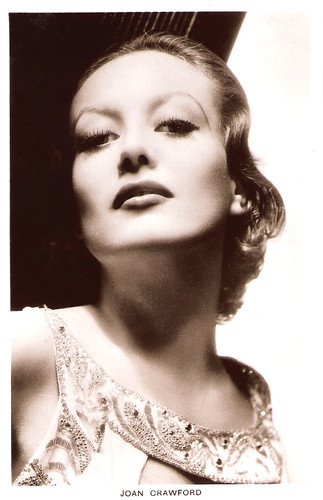
Vintage postcard. Photo: George Hurrell, 1932.

Dutch postcard, no. 571. Photo: George Hurrell / Metro-Goldwyn-Mayer (MGM). Joan Crawford and her second husband Franchot Tone in Dancing Lady (Robert Z. Leonard, 1933).

Dutch postcard, no. 596. Photo: George Hurrell / Metro-Goldwyn-Mayer (MGM). Joan Crawford and Clark Gable in Dancing Lady (Robert Z. Leonard, 1933).

French postcard by Erpé, no. 607. Photo: Metro-Goldwyn-Mayer (MGM). Joan Crawford in Mannequin (Frank Borzage, 1937).

British postcard by Art Photo, no. 164. Photo: Metro-Goldwyn-Mayer. Spencer Tracy and Joan Crawford in Mannequin (Frank Borzage, 1937).

German postcard by Ross Verlag, no. A 1972/1, 1937-1938. Photo: Metro-Goldwyn-Mayer (MGM).

French postcard by E.C., Rueil-Malmaison, no. 58. Photo: Metro-Goldwyn-Mayer (MGM).
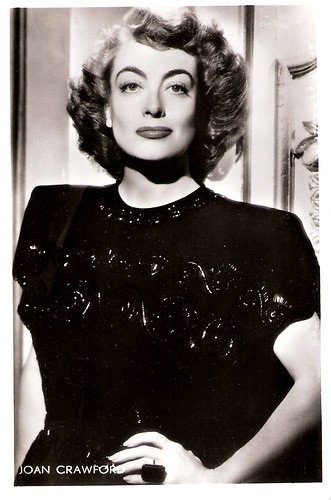
Dutch postcard by J. Sleeding N.V., Amsterdam, no. 11. Photo: Warner Bros.
Sources: Stephanie Jones (The Best of Everything), Michael Elliott (IMDb), Encyclopaedia Britannica, Wikipedia and IMDb.
This post was last updated on 7 November 2023.
No comments:
Post a Comment